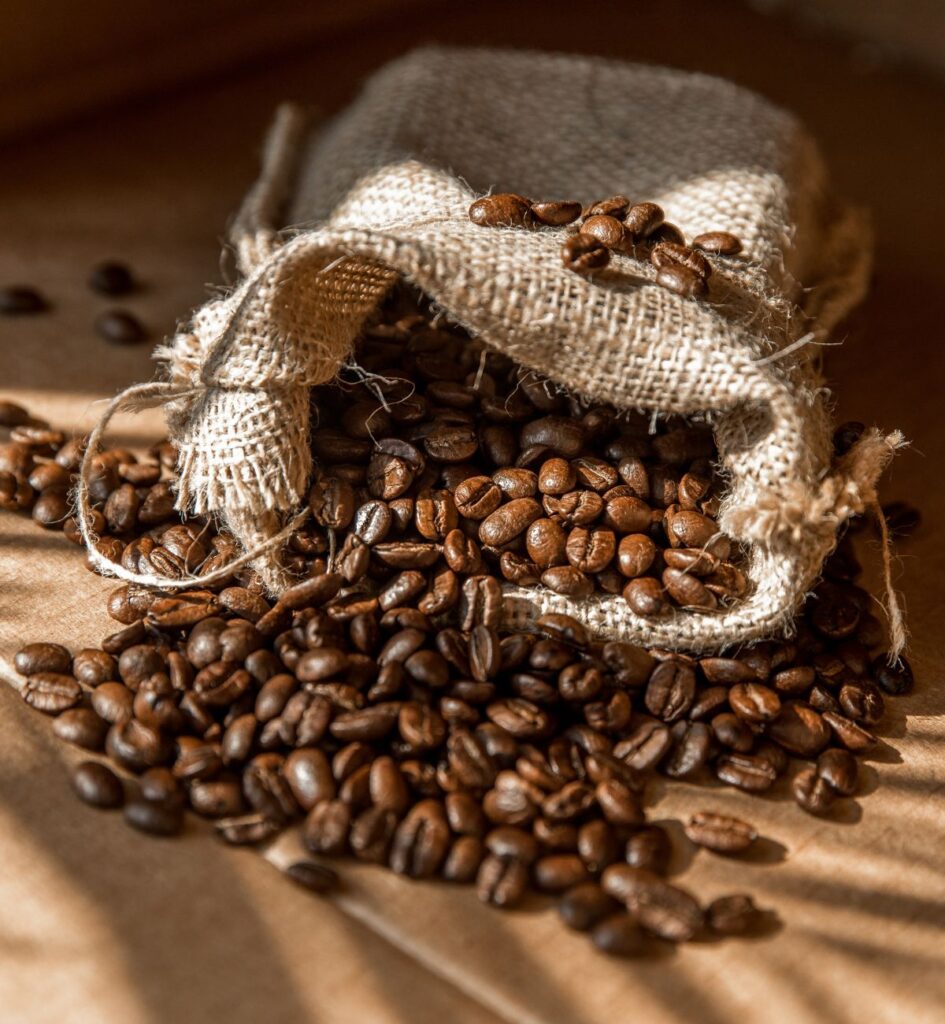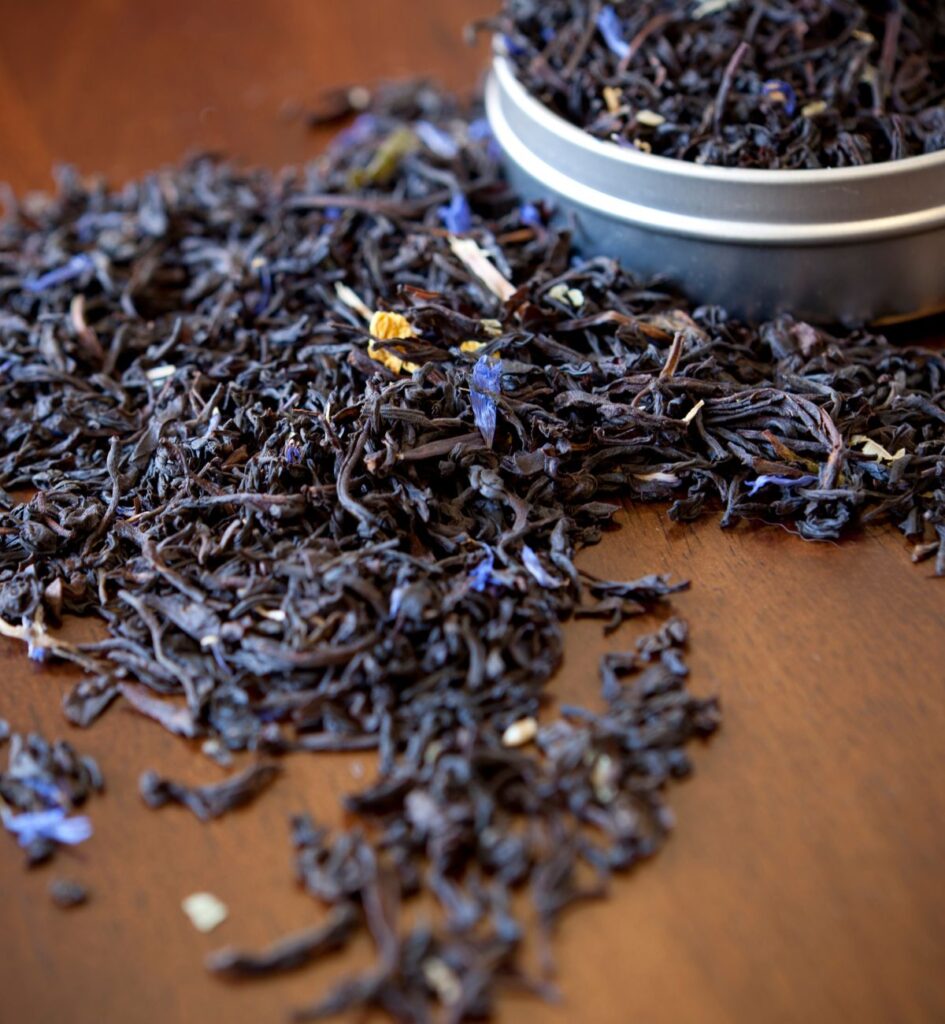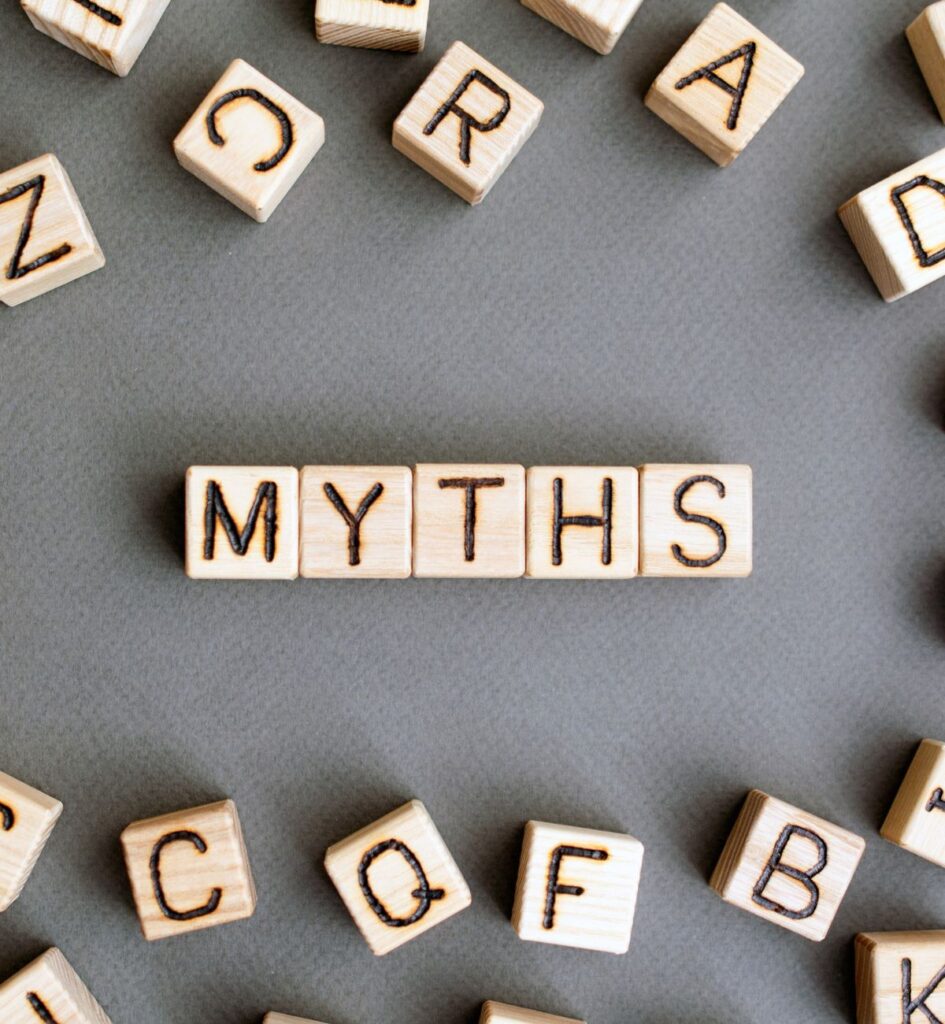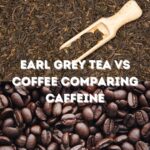Earl grey tea vs coffee comparing caffeine. If you’re a fan of caffeine, you may have wondered which beverage packs a stronger punch – Earl Grey tea or coffee? The debate over which is better has been going on for years, but today, we will delve into comparing the caffeine content in these two popular beverages.
A simplistic side-by-side comparison of a steaming hot cup of Earl Grey tea and a mug of freshly brewed coffee showcasing the contrasting tones of their rich, dark hues. The Earl Grey tea should be presented in a delicate teacup, while the coffee is shown in a rustic, earthy mug. A minimalist backdrop that emphasizes the drinks is suggested.
Before we unveil how these beverages compare regarding caffeine levels, it’s important to understand how caffeine is present in Earl Grey tea and coffee. Let’s dive into the differences between these two drinks and how they may affect your daily caffeine intake.
Understanding Caffeine in Earl Grey Tea and Coffee

Before we compare the caffeine content, let’s understand how caffeine is present in Earl Grey tea and coffee. Caffeine is a naturally occurring stimulant found in the seeds, nuts, or leaves of certain plants. It is known for its ability to increase alertness and concentration, making it a popular ingredient in many beverages, including Earl Grey tea and coffee.
In Earl Grey tea, caffeine is derived from the black tea leaves used to blend. On average, a cup of Earl Grey tea contains about 40-60 milligrams of caffeine. However, the caffeine content can vary depending on factors such as the type of tea leaves, brewing time, and water temperature.
Coffee, on the other hand, contains much higher levels of caffeine. A standard cup of coffee typically contains between 70-140 milligrams of caffeine, depending on the brewing method and type of coffee bean used. This is significantly more than the amount of caffeine found in Earl Grey tea.
The Impact of Brewing Methods on Caffeine Content
The brewing methods used for Earl Grey tea and coffee can also impact caffeine content. For example, brewing Earl Grey tea for a longer time or using hotter water can increase the caffeine levels in the final cup. Similarly, using a finer grind or a longer brewing time when making coffee can produce a higher caffeine content.
However, it’s important to note that the caffeine content in both Earl Grey tea and coffee is not the sole factor that determines their effects on the body. Other considerations, such as the presence of antioxidants and other compounds, can also play a role in their overall health benefits.
"Caffeine is a naturally occurring stimulant found in the seeds, nuts, or leaves of certain plants."
Overall, while coffee contains more caffeine than Earl Grey tea, both beverages can still provide a boost of energy and concentration. The decision between the two may depend on personal preference, as well as other factors such as health considerations and taste.
Caffeine Content in Earl Grey Tea
Earl Grey tea is a popular beverage known for its distinct, fragrant flavor. As with all teas, Earl Grey contains caffeine, although the levels can vary based on several factors, including the brewing method, tea leaves, and serving size.
The average caffeine content in Earl Grey tea is 30-60 milligrams per 8-ounce cup, considered moderate compared to other caffeinated beverages. Nevertheless, it is crucial to acknowledge that the response to caffeine can differ among individuals, and certain people may encounter more pronounced effects despite consuming only a moderate amount of caffeine. (caffeine levels in earl grey tea)
When consumed in moderation, Earl Grey tea has various potential health benefits. The caffeine in Earl Grey tea can help improve mental clarity and focus, boost energy levels, and reduce fatigue. Additionally, studies have shown that tea has antioxidant properties that may have a positive impact on overall health. (effects of caffeine in earl grey tea and coffee)
Adding milk or sugar to Earl Grey tea can dilute the caffeine content and potentially reduce some of the health benefits. Consume it plain or with a small amount of honey or lemon to maximize the advantages of tea. (caffeine levels in earl grey tea)
"Earl Grey tea is a flavorful choice for those seeking a moderate caffeine boost and potential health benefits."
Caffeine Content in Coffee
Coffee is known for its energizing caffeine kick, making it a popular morning beverage choice for many. The caffeine content in coffee varies depending on the type of coffee bean, roast, and brewing method used.
An average cup of coffee (8 ounces) contains around 95 mg of caffeine, according to the National Coffee Association. However, caffeine levels can range from as low as 30 mg to as high as 200 mg per cup.
The caffeine in coffee is absorbed by the body quickly, with effects typically occurring within 15-30 minutes after consumption. Caffeine can boost energy levels, improve alertness, and enhance cognitive function. However, too much caffeine can also have negative effects, such as causing jitters anxiety, and disrupting sleep patterns.
| Type of Coffee | Caffeine Content (mg) |
| Drip coffee (8 oz) | 65-120 |
| Espresso (1 oz) | 47-64 |
| Instant coffee (8 oz) | 30-120 |
| Decaf coffee (8 oz) | 2-5 |
Table: Types of coffee and their caffeine content (adapted from Mayo Clinic)
It’s important to note that the caffeine content in coffee can vary greatly depending on the brewing method used. For example, espresso generally contains less caffeine than drip coffee despite being more concentrated.
The effects of caffeine in coffee can also differ depending on the individual’s tolerance and sensitivity to caffeine. Some people may experience more pronounced effects at lower doses, while others may require higher amounts to feel the same impact.
Comparing Caffeine Levels: Earl Grey Tea vs Coffee

Now that we understand the caffeine content in Earl Grey tea and coffee individually let’s compare the two. According to the USDA, an 8-ounce (240ml) cup of brewed coffee contains around 95mg of caffeine, while an 8-ounce (240ml) cup of brewed Earl Grey tea contains around 20-60mg of caffeine. This means that, on average, coffee contains almost twice as much caffeine as Earl Grey tea.
It’s important to note that caffeine content can vary depending on factors such as brewing time, water temperature, and the type of tea leaves or coffee beans used. For example, steeping Earl Grey tea longer can increase its caffeine content.
To better understand the caffeine content of Earl Grey tea and coffee, let’s take a look at a side-by-side comparison:
| Beverage | Caffeine Content |
| Coffee (8 oz/240ml) | 95mg |
| Earl Grey Tea (8 oz/240ml) | 20-60mg |
As you can see, coffee contains significantly more caffeine than Earl Grey tea. However, it’s important to keep in mind that individual tolerance to caffeine can vary, and too much caffeine can have negative effects on your health. It’s always a good idea to be mindful of caffeine intake and stick to recommended daily limits.
The Verdict
If you’re looking for a beverage with a higher caffeine content, coffee is the clear winner. However, if you’re sensitive to caffeine or prefer a milder energy boost, Earl Grey tea may be a better option. Ultimately, the choice between Earl Grey tea and coffee comes from personal preference and individual health considerations.
Health Benefits of Earl Grey Tea and Coffee

Along with providing a boost of energy, Earl Grey tea and coffee can offer a range of potential health benefits. Here are some of the advantages that these popular beverages may have:
- Antioxidants: Earl Grey tea and coffee are rich antioxidants crucial in shielding your body from the detrimental effects of free radicals. Additionally, these antioxidants possess anti-inflammatory properties, contributing to overall well-being.
- Improved brain function: The caffeine in Earl Grey tea and coffee can help improve brain function, including increased alertness and focus. Additionally, coffee has been shown to potentially reduce the risk of neurological diseases like Alzheimer’s and Parkinson’s.
- Potential weight loss benefits: Earl Grey tea and coffee have been linked to potential benefits. Earl Grey tea may help increase metabolism and aid digestion, while coffee has been shown to suppress appetite and increase calorie burning potentially.
- Reduced risk of certain diseases: Certain diseases may be prevented by consuming Earl Grey tea and coffee, according to several studies. Earl Grey tea has been associated with a decreased likelihood of heart disease and stroke. In contrast, coffee consumption has been correlated with a reduced risk of liver disease and certain forms of cancer.
Although both Earl Grey tea and coffee have potential health benefits, it is crucial to emphasize the importance of moderation. Excessive caffeine intake can result in adverse effects such as anxiety and insomnia. To maintain a healthy balance, experts recommend that adults limit their caffeine consumption to no more than 400mg per day, equivalent to roughly four cups of coffee or eight cups of Earl Grey tea.
“Drinking moderate amounts of coffee, which is up to 3 to 4 cups per day, is not associated with increased risk of any chronic diseases and is beneficial in reducing the risk of several chronic diseases.” – Dr. Frank Hu, Chair of the Department of Nutrition at Harvard School of Public Health.
Overall, both Earl Grey tea and coffee have a lot to offer in terms of potential health benefits. Moderation is key, and it’s always a good idea to consult with your doctor to determine what’s best for your individual health needs.
Earl Grey Tea vs Coffee for Energy: Which is Better?
If you’re looking for a quick energy boost, you may wonder whether Earl Grey tea or coffee is a better choice. Both beverages contain caffeine, which can help improve concentration and alertness. However, there are some differences to consider.
Is Earl Grey tea or coffee better for energy?
Your personal preferences and tolerance for caffeine will determine the answer. Earl Grey tea generally has lower levels of caffeine compared to coffee, resulting in a more subtle energy boost. On the other hand, coffee contains higher amounts of caffeine, leading to a stronger and more immediate surge of energy.
What are the differences between caffeine in Earl Grey tea and coffee?
Caffeine is a stimulant that affects the central nervous system. In Earl Grey tea, caffeine is naturally present in the tea leaves. In coffee, caffeine is extracted from the coffee beans during the brewing process.
The caffeine levels in Earl Grey tea may fluctuate depending on variables like brewing duration, water temperature, and the quality of the tea leaves. Nonetheless, an average cup of Earl Grey tea typically contains around 40 milligrams of caffeine.
In contrast, a cup of coffee can contain between 95-200 milligrams of caffeine, depending on the type of coffee and the brewing method. For example, an espresso shot contains around 63 milligrams of caffeine, while a brewed coffee can contain up to 200 milligrams per cup.
It’s important to note that caffeine affects everyone differently. Some people may feel more energetic and alert after consuming caffeine, while others may experience jitters, anxiety, or trouble sleeping.
Different Types of Caffeine
While both Earl Grey tea and coffee contain caffeine, the type of caffeine they contain may have slightly different effects on the body. Tea contains theophylline, a natural compound that can have a relaxing effect on the muscles and help improve breathing.
Coffee, on the other hand, contains chlorogenic acid, which can help improve cognitive function and alertness.
Ultimately, the choice between Earl Grey tea and coffee for energy depends on your personal preferences and tolerance for caffeine. If you’re looking for a milder energy boost, Earl Grey tea may be a good option. If you need a more immediate and intense energy boost, coffee may be the way to go.
Decoding the Myths: Earl Grey Tea and Coffee

There are several myths revolving around the caffeine content in Earl Grey tea and coffee. Let’s examine some of these myths and determine if they hold any truth.
Myth 1: Earl Grey tea contains no caffeine
This is a common misconception, as Earl Grey tea contains caffeine. While the levels of caffeine may not be as high as coffee, it’s important to note that Earl Grey tea is not a caffeine-free beverage. According to research, a standard cup (8 oz) of Earl Grey tea contains around 20-60 mg of caffeine, depending on the type of tea and brewing time.
Myth 2: Drinking coffee will dehydrate you
Many people believe that coffee acts as a diuretic, causing dehydration. However, studies suggest that moderate coffee consumption (up to 3-4 cups per day) does not have a significant impact on hydration levels. Coffee can contribute to daily fluid intake, especially if consumed with water.
Myth 3: Light roast coffee has less caffeine than dark roast coffee
Contrary to popular belief, the roasting process does not have a significant impact on caffeine levels in coffee. The difference in caffeine content between light and dark roast coffee is negligible. The type of coffee bean and brewing method has a greater impact on caffeine content.
Myth 4: Decaf coffee is completely caffeine-free
While decaf coffee contains significantly less caffeine than regular coffee, it is not entirely caffeine-free. According to USDA regulations, decaf coffee must have less than 2.5% caffeine by weight. This means that an 8 oz cup of decaf coffee can still contain up to 5-7 mg of caffeine.
By debunking these myths, we can have a better understanding of the true caffeine content in Earl Grey tea and coffee. Remember to consume both beverages in moderation and consult with a healthcare professional if you have any concerns about caffeine intake.
Recommended Daily Consumption: Earl Grey Tea vs Coffee
It’s important to understand how much caffeine is safe to consume each day. Excessive caffeine intake can lead to negative side effects such as jitters, insomnia, and anxiety. The Food and Drug Administration recommends no more than 400 milligrams of caffeine daily for healthy adults.
The caffeine content in Earl Grey tea and coffee can vary depending on the brewing method, serving size, and type of beverage. Here’s a breakdown of the average caffeine content in each:
| Beverage | Caffeine Content (per 8 oz serving) |
| Earl Grey Tea | 25-50 milligrams |
| Coffee | 95-165 milligrams |
As you can see, coffee generally contains more caffeine than Earl Grey tea. However, it’s important to note that the brewing method and serving size can greatly impact the caffeine content. Additionally, some types of coffee, such as decaf, contain much less caffeine than regular coffee.
If you’re trying to limit your caffeine intake, opt for smaller servings and consider switching to decaf for a lower caffeine content. Remember to keep track of your caffeine intake and listen to your body if you’re experiencing negative side effects.
The Impact of Brewing Methods on Caffeine Content
Did you know that the brewing methods for Earl Grey tea and coffee can impact the caffeine content in your cup? Here’s what you need to know:
Earl Grey Tea: The caffeine content in Earl Grey tea can vary depending on the brewing time and temperature. Generally, steeping for 3-5 minutes at 180-200°F will extract around 20-30 mg of caffeine per 8 oz. cup. However, if you steep for longer or use hotter water, the caffeine content can increase.
Coffee: The brewing method has a significant impact on coffee’s caffeine content. The longer the brewing time, the more caffeine is extracted. For example, a cup of drip coffee contains around 95 mg of caffeine per 8 oz., while an espresso shot has around 63 mg.
It’s important to follow recommended brewing guidelines and measurements for Earl Grey tea and coffee to ensure consistency in caffeine levels.
Making the Right Choice: Earl Grey Tea or Coffee?
After exploring the caffeine content and health benefits of Earl Grey tea and coffee, it’s time to make an informed decision about which beverage is right for you. Keep in mind that the answer will depend on your personal preferences, caffeine tolerance, and health goals.
If you’re looking for a lower-caffeine option, Earl Grey tea may be the way to go. On average, Earl Grey tea contains around 55 mg of caffeine per 8-ounce serving, while a cup of coffee can range from 70-140 mg or even higher in specialty drinks.
However, it’s worth noting that the caffeine content in Earl Grey tea can vary depending on the brand and brewing method. If you’re particularly sensitive to caffeine, opt for decaf or herbal tea instead.
On the other hand, if you need a stronger pick-me-up or enjoy the taste of coffee, then a cup of joe may be the better choice. Coffee has several health benefits, including improved cognitive function and a lower risk of diseases like type 2 diabetes and Parkinson’s.
It is imperative to practice moderation when enjoying Earl Grey tea and coffee as part of a balanced eating regimen. Overindulgence in caffeine can result in detrimental consequences such as increased anxiety levels, insomnia, and a raised heart rate. If you possess any apprehensions about your caffeine intake, consult with your healthcare provider for guidance.
Remember, the decision between Earl Grey tea and coffee is a personal one. Consider your taste preferences, health goals, and caffeine tolerance to make the right choice.
Conclusion
After comparing the caffeine content in Earl Grey tea and coffee, it’s clear that coffee typically contains more caffeine per serving. However, it’s important to remember that the exact caffeine levels can vary depending on various factors, including the type of coffee or tea and the brewing method used.
While caffeine is often consumed for its energizing effects, Earl Grey tea and coffee offer additional health benefits that may appeal to you. For example, Earl Grey tea is loaded with antioxidants that can help fight inflammation, while coffee has been shown to reduce the risk of liver disease and certain types of cancer.
When it comes to choosing between Earl Grey tea and coffee, it ultimately depends on your personal preferences and needs. If you’re looking for a higher caffeine content, coffee may be the better choice. However, if you’re looking for a milder source of caffeine or trying to reduce your caffeine intake, Earl Grey tea may be the way to go.


